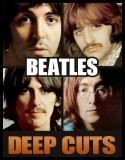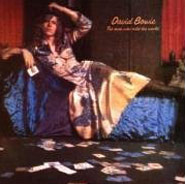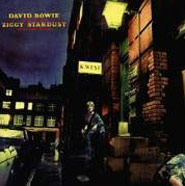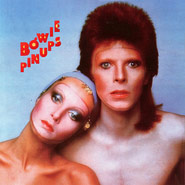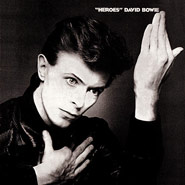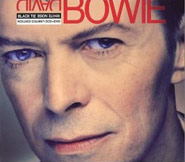Deep Cuts: David Bowie
09/18/2006
Music Home / Entertainment Channel / Bullz-Eye Home
ALSO: Have a comment or a question? Post it at EatSleepDrinkMusic.com!
Compiling a Deep Cuts list for David Bowie might seem like a daunting task. The man’s had so many albums and so many great non-single album tracks that it’s undoubtedly impossible to create a list which every fan will agree with. Just look at the number of official compilations Bowie’s already issued and you’ll begin to get the picture (for my money, the best single disc collection remains Rykodisc’s Changesbowie which collects most of Bowie’s hit singles starting with “Space Oddity” and ending with “Blue Jean”). There’s just so much to work with in the man’s catalogue that it can be perplexing, even for record companies to put together something for the fans.
Many of those fans draw a line of demarcation between the Scary Monsters album and everything that came afterward. There seems to be an unspoken universal Bowie rule that says Scary Monsters is the last “important” release Bowie has made, and Let’s Dance is where he started becoming more of a follower than a leader. Personally, I don’t look at it that way. I see a lot of Bowie’s post-Scary Monsters work to be when the rest of the world caught up with him, and the man just relaxed while it did. And you can’t fault the guy for some of those ‘80s albums. Hell, a lot of great artists floundered during that decade, especially those who had been around since the ‘60s.
At any rate, here are some of Bowie’s best album cuts in chronological order. Most every album is included here, including those two Tin Machine studio discs. It’s a lengthy journey, but one that pays off greatly, especially if you’re just a casual fan of the man’s work. Davie Bowie’s certainly one of those artists whose album tracks are as entertaining and challenging as his hit singles. But enough presentation: let’s get straight to David Bowie’s Deep Cuts.
All songs by David Bowie, except where indicated.
“The Gospel According to Tony Day” – The Deram Anthology 1966-1968
If you’re going to start somewhere, let this be it. Bowie’s pre-“Space Oddity” fluff has been repackaged countless times and alienates even the most dedicated of fans thanks to its oddball non-rock style. This weird ass song combines freaky woodwinds over a stoned blues groove, while David croons such banalities as “Your mind, blow it, blow it” and “The Gospel according to Marianne Brent / She’ll be mine if I pay the rent.” Bowie even drops an f-bomb here. Quite racy for the times and a good example of why David’s early attempts to be a pop star went rather unnoticed.
“Janine” – Space Oddity
The Space Oddity album finds Bowie still trying to decide what to do. The album alternates between wonky late-‘60s hippy-dippy schmaltz and genuine attempts to break free and create something original. This rocking track is certainly a highlight of the disc, foreshadowing the style that would permeate the next album, while breaking free of Space Oddity’s own orchestrated coffeehouse silliness.
“The Width of a Circle” – The Man Who Sold the World
Bowie meets up with Mick Ronson, leaves behind his pretty acoustic trip, and rocks insanely hard on his second album. This was what was known as “epic” back then, clocking in at over eight minutes and setting the stage for the rest of the disc. The lyrics are still getting there, but the music is propulsive and unlike anything Bowie had done before. Indeed, it was the first step towards an artistic makeover, not to mention the cover art for the album which found Bowie lounging on a day bed in a man’s dress looking like a woman. Naturally, the US sleeve was changed.
“The Man Who Sold the World” – The Man Who Sold the World
The title track to this album has been covered by plenty of people, including every kiddie’s favorite Kurt Cobain. There’s a good reason for that. It’s a damned creepy song with lyrics that touch on paranoia and post-apocalyptic doom, two of Bowie’s favorite themes. But the thing about it is the song has a majestic quality about it that lifts the gloomy lyrics into a rarified atmosphere that probably wouldn’t be achieved by your garden variety artist. Bowie’s metamorphosis into being a musical chameleon is now almost complete.
“Song for Bob Dylan” – Hunky Dory
Hunky Dory is Bowie’s first all-around great album. He’s finally found his footing and dishes out an array of styles, all of which work flawlessly. This track is like a double-edged sword, coming across as both scathing and praising at the same time. Certainly, though, for a relative newcomer like Bowie, putting down Dylan in song on a popular album was pretty radical. “Andy Warhol,” from the same album, also at times seems like a put-down, but Bowie was enamored with the artist, so it’s obvious his talent for ambiguity was here early on.
“Queen Bitch” – Hunky Dory
David Bowie loved the Velvet Underground. At the time, that band had already dissolved and was still very much unknown. Bowie himself would soon be covering VU standards like “White Light/White Heat” and “I’m Waiting for the Man” in concert, while introducing Mott the Hoople to “Sweet Jane.” “Queen Bitch” is Bowie’s tribute to the VU, all three chords and simple during the verses. Of course, it’s much more glam than anything Lou Reed did with his old band, but it’s still instantly catchy and Bowie’s refrain of “You betcha!” at the end is one of the best moments ever in rock music. Very sexy, very classic.
“Soul Love” – The Rise and Fall of Ziggy Stardust and the Spiders from Mars
Bowie pushed full throttle on his breakthrough album and this song, like “Drive-In Saturday” from Aladdin Sane, finds him embracing old doo-wop textures and mixing them with ‘70s street savvy swagger. The sax solo sounds like it walks in from outer space yet somehow works anyway. By now Bowie knew exactly how to get the sounds and ideas he wanted perfectly. He could do pretty much anything and it worked, sounding like no one else but David Bowie, even though that originality was borrowed from everywhere. But that was the beauty of it.
“Star” – The Rise and Fall of Ziggy Stardust and the Spiders from Mars
“I could make a wild mutation as a rock and roll star,” sings Bowie. How calculating and psychic he was on this track. He’d transform himself from the quasi-normal looking Bowie on the cover of the album into the red haired alien all multi-sexual and decadent by the time the show hit the road. While his hippie friends he sung about in the song were either off fighting the war or starving for peace, Bowie would heed his own Ziggy’s call and reap the rewards of being a larger than life rock icon. Pure genius through self-creation, distribution, and promotion.
“Lady Stardust (demo)” – The Rise and Fall of Ziggy Stardust and the Spiders from Mars: 25th Anniversary Edition
While the official version of this song is grand and glam, the stripped-down demo recording of Bowie at his piano singing this song really brings out the beauty of the track. It’s far more heartbreaking and intimate than the Spiders’ version. This take is also available on the Rykodisc reissue of the Ziggy Stardust album.
“Sweet Head (take 4)” – The Rise and Fall of Ziggy Stardust and the Spiders from Mars 25th: Anniversary Edition
Bowie brings Ziggy’s psycho-sexual prowess to the fore on this track. He promises to “give you sweet head” while professing to be “your rubber peacock, angelic whore…I’m the wrought iron face upon your wall.” Mix this with the stage theatrics of Bowie going down in front of Ronno’s crotch while he was stoking his guitar, and you’ve really got yourself quite the image. Also available as well on the Rykodisc Ziggy reissue.
“Watch That Man” – Aladdin Sane
Bowie finally broke free of jolly old England and spent some time in America, which influenced a lot of the songs on Aladdin Sane. This great opening track is a lyrical mish-mash that doesn’t need to make sense. It just simply sounds great – that is, if you can even make any of it out. The vocals weren’t supposed to be buried in the fashion that they are, but Bowie liked it when he heard the mix, and so they stayed in the background.
“Panic in Detroit” – Aladdin Sane
One very wacked-out song, both musically and lyrically. Bowie was getting more down with the drugs during this time, and his paranoid experiences during his trip to the States were seeping into his ideas. He was quoted at the time as saying there were all these people on the rooftops with guns. Call it coke-induced mania. Still, it made for an interesting song. You can literally feel the junkie fever dream as the song oozes out of the speakers.
“Lady Grinning Soul” – Aladdin Sane
The closer to the album that would be the epitaph to the whole Ziggy/Aladdin creation. Again, the words are weird and paint a disturbing and surreal portrait. “Cologne she’ll wear, Silver and Americard / She’ll drive a Beetle car / And beat you down at cool Canasta.” Just think, four or five years earlier and this kind of thing would have been passed over as some amateur’s psychedelic bullshit in the wake of the Beatles. But Bowie was controlling the whole thing by now and his fans hung on every word.
“See Emily Play,” “I Can’t Explain,” “Anyway, Anyhow, Anywhere” – Pin Ups
(by Syd Barrett, Pete Townshend, and Pete Townshend and Roger Daltrey, respectively)
These three tracks from Bowie’s all-covers album pretty much say it all for the entire collection. He takes the songs (here by Pink Floyd and the Who, respectively) and sexes them up, throws some of his sax on top, and changes them into sweaty tracks that don’t really resemble the originals. You’re either a fan of Pin Ups, or you think it’s just daft shit. At the time, it was sort of remarkable in that Bowie was introducing fans to some songs that they probably didn’t hear otherwise. I don’t detest the album as much as I used to, but it’s still just a cough in the Bowie canon.
“Alternative Candidate” – Diamond Dogs: 30th Anniversary Edition
So many of the great songs from the Diamond Dogs album proper were released as singles either in the States or the UK, so we’re pretty much left to choose from things that didn’t make the official album. This track, which is also available on the Rykodisc reissue of Diamond Dogs, is killer, however. It lays down a much more soulful and – once again – sexy groove compared to the version of “Candidate” on the regular LP. The opening lines say it all one again: “Inside every teenage girl there’s a fountain / Inside every young pair of pants there’s a mountain.”
“Dodo” – Diamond Dogs 30th Anniversary Edition
Another track that originally surfaced on the early ‘90s Rykodisc reissue of Diamond Dogs. This one was originally part of a strange single that mashed the song together in medley form with the “1984” tune that appeared on the official album. It was a different version altogether, mind you. This one’s a bit sleazier with a funky horn section and a little more laid back. A real treat.
The David Live album
This album has recently been reissued once again and includes the entire show in its original sequence, something both the original vinyl and Rykodisc reissues did not. The sound is also greatly improved. I was going to pick the great cover on “Knock on Wood” here as a Deep Cut, but damned if it wasn’t actually released as a single. Ah well. The new version is definitive at least, and finds Bowie going into his Philly soul groove with the Diamond Dogs and Ziggy-era material.
“Win” – Young Americans
When Bowie killed off Ziggy, fans were disappointed, but he soon came back with the same freaky red hair and lipstick-laden blowjob rock for Pin Ups and the sci-fi post-apocalyptic lunacy of Diamond Dogs. But when he delivered Young Americans, with its Philly soul and disco grooves that everyone else would be latching onto soon enough, the fans were pissed. This song is one of the best from the album, with cascading saxes, a drugged-out pace, and Bowie getting into full croon mode, dishing out such lines as “Me, I’m fresh on your pages,” that I wished I had written.
“Can You Hear Me?” – Young Americans
Another slow burner from the album. This one’s a lot like “Win,” except there’s more guilty pleading and more sex oozing from the backup singers. It’s as plastic as David got in the ‘70s, and by the time every one else decided to hitch a ride on the sound, he was already into something new. Something new and something far scarier and detached that the disco freaks wouldn’t want to touch with a ten foot pole.
“Station To Station” – Station To Station
For this album, Bowie reinvented himself as the Thin White Duke, and borrowed a chapter from the Germans as far as theatricality went. It was all black and white with pinpoint spotlights and cold-as-ice delivery. Ziggy and the red hair were gone for good. The glam was dead and it was onward to the creepier machinations of rhythm and sound that bands like Kraftwerk were beginning to bring over from Europe. On the title track, Bowie offers up two stunningly brilliant musical sections. The first churns along slowly, building up the tension perfectly with the sounds of a train working behind it, all steamy and rigid. The second half breaks free of its restraints, suddenly exploding into a mesmerizing dance track, celebrating drugs (“It’s not the side effects of the cocaine / I’m thinking that it must be love”) and getting down harder than anything on Young Americans. It’s the high point of Bowie’s ‘70s career, completely stripping away everything that had come before and rolling forward with a crushing determination.
“Always Crashing in the Same Car” – Low
For Bowie’s first outing with Brian Eno, the sound was a little warmer and fuzzier than that of Station to Station. There was an artsy-sounding single (“Be My Wife”), along with a downright catchy one (“Sound and Vision”), and a whole host of instrumental noodlings taking up the second half of the LP. This tune is easily the weirdest of the vocal songs, as long instrumentally as it is lyrically. It opens in a strange haze, with a synth line that will later be recycled in “Heroes” an album later. The words have something to do with a chick named Jasmine watching from her hotel window as Bowie races his car around the parking lot. Strange stuff.
“Joe the Lion” – Heroes
Where Low was filled with moody ambient instrumentals courtesy of Brian Eno, Heroes finds Bowie taking the reigns back a bit more. It’s a very polarizing album. There are a lot of abstract rhythms and melodies, but it’s one of those discs that pays off with repeated listens. This tune is almost as groovy as the album opener “Beauty and the Beast” with its weirdo lyrics, treated vocals, and sense of some kind of futuristic doom. Bowie was out to show the punks that he wasn’t going anywhere. He succeeded.
“Sons of the Silent Age” – Heroes
The surreal quality that infuses this song is enough to make one think of the silent film era and such works as Fritz Lang’s Metropolis and Dali’s Un Chien Andalou. “Sons of the Silent Age, listen to tracks by Sam Therapy and King Dice,” and “make love only once but dream and dream,” Bowie informs us. Hey, it’s good enough for me after all these years.
The Stage album
This is Bowie’s other ‘70s double album that has recently been reissued with all tracks and in the correct order corresponding to the show. It’s a tight performance, and sounds and comes across better than David Live. Even the instrumental tracks somehow work, which has always made me wonder what the hell Bowie’s stage presence was like during those moments of those shows. Not really any deep cuts here, but a great listen nonetheless.
“Red Money” – Lodger (by David Bowie and Carlos Alomar)
Lodger has never been a fave Bowie album of mine. “Boys Keep Swinging,” “DJ,” and “Fantastic Voyage” are all good cuts, but overall, I’ve always been a little put off by the songs overall. There’s something almost impenetrable about them. “Red Money” closes the LP and is like a working model for the far better strange yet inviting sounds David would explore on his next album.
“Kingdom Come” – Scary Monsters (by Tom Verlaine)
Tom Verlaine’s tune is transformed into a huge sounding piece of epic proportions here, almost Phil Spector-like. Bowie has always chosen interesting songs to cover throughout his career, and this one is certainly a highlight both of it and the album it comes from. He sings it in a sort of affected style, but it works well nonetheless.
“It’s No Game (Part 2)” – Scary Monsters
The second version of the song that opens the album closes it on a funky, new wave note. You can tell Bowie had been listening to bands like Television in Carlos Alomar’s guitar playing throughout the album, and here they break along in similar fashion. As Bowie sums it up at the end, “Children ‘round the world put camel shit on the walls / They’re making carpets on treadmills, or garbage sorting.” You can only listen and accept it, going along for the strange ride once again.
“Space Oddity” (Re-recorded b-side for “Ashes to Ashes”, also available on the Rykodisc reissue of Scary Monsters)
I’ve never really enjoyed the original version of this song, but this remake specifically recorded for the flip side of “Ashes to Ashes” totally kills. It sounds crisp and stark, with beautiful spare piano chords. It’s the sound of desolation and emptiness, the way the song should have sounded the first time around.
“Without You” – Let’s Dance
The line of demarcation has been drawn. After working with Queen on “Under Pressure,” Bowie keeps a low profile for a couple years and then emerges once again with Let’s Dance, the plastic album that will sell shitloads of copies. It’s not a bad album at all, and the singles are still groovy. This track has always been my favorite as far as the album cuts go. It’s sleek and soulful and it actually does feel like Bowie means it, a quality that would start to disappear quickly on subsequent releases.
“Farewell Speech” – Ziggy Stardust – The Motion Picture (2003 reissue)
The movie and concert album for Ziggy’s final show has always been a hodgepodge, and even the expanded 2003 edition with much improved remixing can’t cover up the fact. Still, you get to hear Bowie give his farewell to a stunned audience (and band; Mick Ronson was the only one who knew Bowie was going to make his announcement prior to the show). If only more bands had done the same at the time and just permanently shut up. Bowie just had to kill the monkey on his back before he could continue. This was a groovy way to go out on the first part of his career.
“I Keep Forgetting” – Tonight (by Jerry Leiber and Mike Stroller)
Tonight has always been dubbed Let’s Dance Part Two, but if that were the case, it’d be much more enjoyable than it is. Honestly, I’ve never found much to like on this album, save for the great “Blue Jean.” This bastardized cover of “I Keep Forgetting” sounds like typical ‘80s pop, with a bouncy rhythm, god-awful electronic drums, and Bowie sounding uncomfortable as hell in the middle. If for no other reason than that, you need to hear this tune.
“Too Dizzy” – Never Let Me Down (original pressings only) (by David Bowie and Erdal Kizilcay)
Some say that Never Let Me Down is even worse than Tonight, but I disagree. Bowie at least seems a little more energized now with Peter Frampton (!) in the guitarist’s seat. The title track and “Day In Day Out” aren’t horrible, either, especially the former. Anyway, all subsequent reissues of the album deleted “Too Dizzy” from the track list. Some speculate it’s because of the misogynistic lyrics, but they’re hardly anything compared to a lot of other songs. It’s one of the best songs on the album, period, and shows that Bowie could have transformed the cheapie ‘80s sounds into his own thing easily if he had only wanted to more often.
“Crack City” – Tin Machine
For the first time since the Spiders from Mars, Bowie assembled a “real band” to record albums with and tour. Most everyone didn’t like the group, probably because Bowie was so insistent on really forgetting everything that had come before and just focusing on this new sound, which was actually leaps and bounds better than what he made on Tonight and Never Let Me Down. “Crack City” is a nifty song, a cautionary tale against drug use that includes the terrific lines “They’re just a bunch of assholes / With buttholes for their brains.” You tell ‘em, Dave!
“Fame ‘90” (House Mix and Absolutely Nothing Premedtiated-Epic Mix) – “Fame ‘90” CD single) (by David Bowie, John Lennon, and Carlos Alomar)
When Rykodisc acquired Bowie’s back catalogue in 1990, they created the new Changesbowie compilation and on it offered up “Fame ‘90,” a reworking of the hit song “Fame” from Young Americans. Personally, I’ve always preferred “Fame ‘90.” The rhythms are tighter and it’s a hell of a lot funkier. The CD single offered up four more variations, with these two being the best. The “House Mix” of course features the famous techno house piano backdrop that was so prevalent in popular house music of the time, and the “Epic Mix” is almost 15 minutes long, going through three equally groovy movements. This CD single was originally sold separately and also packaged together with the Young Americans reissue, along with a little CD holder, which is how I got mine.
“One Shot” – Tin Machine II (by David Bowie, Reeves Gabrels, and Hunt and Tony Sales)
Bowie wasn’t ready to kill Tin Machine just yet (they’d even have a live album before that happened), so the band sent out another disc, more noteworthy of the time for the censoring of the album cover than the actual music (which again isn’t terrible at all). This track finds Bowie finding some great footing once again with spectacular guitar work by Reeves Gabrels and some super background vocal harmonies. It’s actually kind of hard to fathom why Tin Machine wasn’t a little more successful. A lot of this stuff seems like it would be right in step with so much of the alternative rock that was getting popular at the time.
“Real Cool World” (12” Club Mix) – “Real Cool World” CD single
Cool World was a terribly shitty movie with a really great soundtrack. This song has always been one of Bowie’s best forays into electronic dance music, and the 12” mix expands the territory by a minute or so and gets funkier than the single edit. In fact, this was definitely the precursor to the next sound that Bowie was going to lay on all his fans.
“I Feel Free” – Black Tie White Noise (by Jack Bruce and Pete Brown)
On Black Tie White Noise, Bowie embraced and created his own take on the techno/electronica sound, reaching out to an entirely new audience and succeeding on that level quite well. Older fans weren’t quite sure what to make of it, and the album has often been chided for being “trendy.” Whatever. This track is super funky, with Bowie going to town in full-croon mode while Edge-like guitars and a fantastic bass line keep everything down tight.
“Nite Flights” – Black Tie White Noise (by Scott Engel)
Another funky excursion whose bass line echoes that of “The Wedding Song” on the same album. Apparently marrying Iman really rejuvenated Bowie all around, bringing out the best in him once again. If you haven’t listened to this disc in a while, go back and rediscover it, as there’s some really great music throughout, and it’s a much more successful album as a whole (sound-wise, that is) than some of the albums that followed.
“Jump They Say” (Jae-E mix) – “Jump They Say” CD single #1
There were three CD singles issued for this song from Black Tie White Noise. This mix is actually similar to the “Radio 1 edit” mix that appeared on the original pressings of the album, but it’s a bit longer. It’s a stripped-down mix, with sounds of female orgasmic gasps and loops of “David’s talking” in the background. Focusing less on the horn parts and more on the groove, it’s one of Bowie’s best remixes out there.
“The Motel” – Outside
This is from one of those Bowie albums you either have time to listen to or don’t give a damn for. It does drag on terribly long, but a lot of fans swear by it. It was supposed to be the first chapter of a three-part trilogy that never was completed. This tune is creepy enough, with a piano figure that echoes the stuff on Aladdin Sane. But overall, the whole damn thing was just too much and perhaps Bowie felt the same way, abandoning the overall project to move along.
“Looking for Satellites” – Earthling (by David Bowie, Reeves Gabrels, and Plati)
Where Black Tie White Noise found Bowie creating his own techno/dance style, Earthling found him incorporating the then-popular jungle style of dance music, with varying results. It’s a decent album, but one can’t help but feel that Bowie missed his mark. This song is a slow burner built around a quasi-chant and the whole thing becomes a little hypnotic as it rolls along.
“New Angels of Promise” – Hours (by David Bowie and Reeves Gabrels)
Hours is the point where Bowie started to regain critical acclaim once again. The album overall isn’t terribly dynamic, giving over to a lot of slower, moodier stuff. This song is the cream of the crop, though, if we’re not talking about the singles taken from the disc. It’s atmospheric in a way a lot of the other songs on the album aren’t, feeling a little more open. Nice guitar work and that patented built-up and dramatic Bowie vocal style is at the fore.
“I Took a Trip on a Gemini Spacecraft” – Heathen (by Norman Carl Odam)
This is one of those Bowie albums that I still haven’t fully embraced, and I may not ever. It’s not bad at all, it’s just not what I consider to really be an engaging Bowie album. Perhaps coming from someone else, it would work much better. Still, this is a good album track, with another interesting vocal performance and a touch of the old electronica to propel it forward.
“Pablo Picasso” – Reality (by Jonathan Richman)
We’ll close David Bowie’s Deep Cuts with this, a cover of the classic Jonathan Richman tune. It’s another perfect example of Bowie taking someone else’s old clothes and making them new again. John Cale had done it with the same song years before, and Bowie kills it and takes control of the machine once again. And that, as they say, is that.






